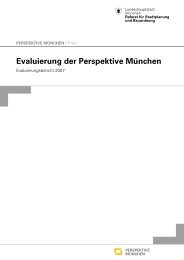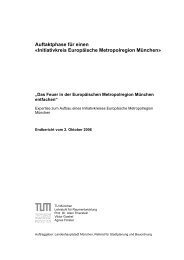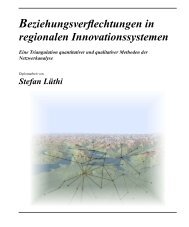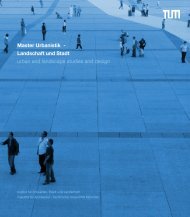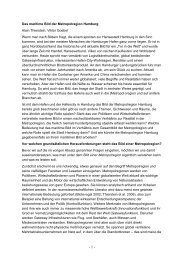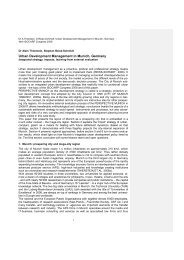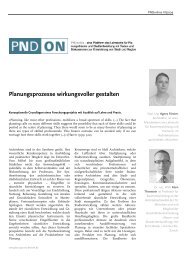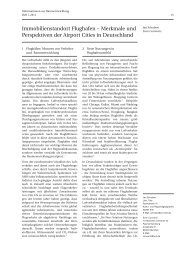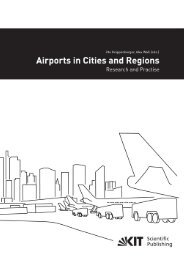0.6-1-Cover and Table of Contents-pp 0-05.indd - Raumentwicklung ...
0.6-1-Cover and Table of Contents-pp 0-05.indd - Raumentwicklung ...
0.6-1-Cover and Table of Contents-pp 0-05.indd - Raumentwicklung ...
You also want an ePaper? Increase the reach of your titles
YUMPU automatically turns print PDFs into web optimized ePapers that Google loves.
MAHMOUD REZA SAGHAFI, JILL FRANZ, AND PHILIP CROWTHER<br />
Perceptions <strong>of</strong> Physical versus Virtual Design Studio Education<br />
each aspect. Participants explained their answers<br />
during their final interview through reviewing their<br />
survey <strong>and</strong> commenting on the selected answers.<br />
The main purpose <strong>of</strong> designing the survey was<br />
to compare different learning activities, design<br />
studio aspects, <strong>and</strong> participants’ feelings in both<br />
PDS <strong>and</strong> VDS through three-choice answers.<br />
Methodology<br />
The collected data were analyzed using<br />
grounded theory methodology as outlined by<br />
Charmaz (2006). Data was separated, sorted,<br />
<strong>and</strong> synthesized through qualitative coding<br />
which occurs by attaching labels to parts <strong>of</strong><br />
data (Charmaz, 2006: 3). Strauss <strong>and</strong> Corbin<br />
(1990) describe data analysis in a grounded<br />
theory a<strong>pp</strong>roach as the process <strong>of</strong> separating,<br />
conceptualizing, <strong>and</strong> putting data back together<br />
in new way to evolve a different underst<strong>and</strong>ing <strong>of</strong><br />
phenomena <strong>and</strong> allow a comparison between<br />
the elements <strong>of</strong> different learning environments <strong>of</strong><br />
the case study.<br />
The process <strong>of</strong> analysing data<br />
The data for this study were managed <strong>and</strong><br />
subjected to another level <strong>of</strong> analysis using<br />
NVIVO 8 s<strong>of</strong>tware. NVIVO was used to facilitate<br />
the archiving, coding, <strong>and</strong> analysing <strong>of</strong> data as<br />
conveyed in Figure 1. The s<strong>of</strong>tware enabled the<br />
formation <strong>of</strong> free <strong>and</strong> tree nodes similar to open<br />
<strong>and</strong> axial coding in grounded theory. Categories<br />
<strong>of</strong> nodes were then configured to produce<br />
concepts corresponding to selective codes in<br />
grounded theory. Following this process, different<br />
factors in both PDS <strong>and</strong> VDS were compared<br />
based on their benefits <strong>and</strong> limitations. They<br />
were analysed again to clarify advantages <strong>and</strong><br />
disadvantages informing the development <strong>and</strong><br />
evaluation for a subsequent study <strong>of</strong> a blended<br />
learning environment.<br />
Figure 1:The process <strong>of</strong> archiving, coding, <strong>and</strong> analyzing<br />
data in six stages (Source: Authors).<br />
Fundamental to this is a process <strong>of</strong> open, axial, <strong>and</strong><br />
selective coding. This process involves developing<br />
various concepts <strong>and</strong> identifying links between<br />
concepts for capturing the characteristics <strong>of</strong> the<br />
central phenomena in the field <strong>of</strong> study (Strauss,<br />
1987). Corbin states that the process <strong>of</strong> coding<br />
occurs within a consequential matrix work as<br />
a framework. This matrix enriches analysis by<br />
classifying the consequences in which setting are<br />
located <strong>and</strong> responded to (Corbin <strong>and</strong> Strauss,<br />
2008).<br />
Theoretical framework<br />
Effective learning depends on various internal<br />
<strong>and</strong> external conditions (Kearsley <strong>and</strong> Moore,<br />
1994) including the learning environment that<br />
can affect learning in different ways. Karakaya<br />
<strong>and</strong> Pekta (2007: 138) propose that without a<br />
Archnet-IJAR, International Journal <strong>of</strong> Architectural Research - Volume 6 - Issue 1 - March 2012<br />
9



